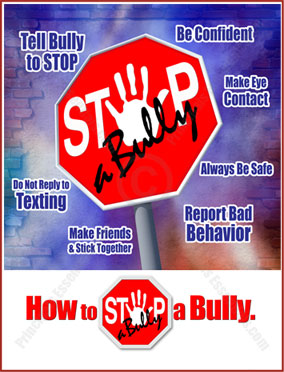5 Ways to Stop Bullying
The core of the our Bully Prevention program is designed to set clear, school-wide procedures, empower victimized students, promote safe behavior and put the school bullies on notice.
School Administrators can help put an end to bullying by getting parents, teachers, crossing guards and the whole community involved. Schools should adopt an anti-bullying pledge program with a visible campaign that instructs students on how to deal with a "Bully".
1.Have students recite and sign our Stop Bullying Pledge Cards. Schools should adopt an anti-bullying pledge and provide instruction on how to deal with a "Bully" when confronted. Students commit to the elimination of bully activity in their school by signing a "Take the Stop-a-Bully Pledge" contract.
2. Appoint a "School Safety Team" to review complaints. Elect an Anti-bullying Coordinator to investigate complains. Offer training for all teachers so that they can recognize and deal with bullying and suicide prevention.
3.Set school-wide policy and enforce it. Hang our Bully Prevention Posters throughout your school, giving students instruction on how to handle a situation that involves bullying. Students should always be encouraged to report bullying when they see it. All consequences should include counseling. School staff must report any alleged cases and witnesses must write reports within 48 hours.
4. Show Our Stop School Bullying Presentation at an Assembly. Download and present our FREE Stop School Bullying Powerpoint to students. Teach students how to identify a bully, how to deal with dangerous situations and encourage students to break the silence and speak out against bullying and school violence. Have a question and answer session at the end of the assembly. Ask students about their ideas on the bully prevention.
5. Encourage Students to Report Bad Behavior. Offer students 2 ways to report, confidentially or by talking to a teacher they are comfortable with. Students should always try to walk away from bullies before the situation escalates to violence. A bully's number one goal is to provoke a reaction.
The core of the our Bully Prevention program is designed to set clear, school-wide procedures, empower victimized students, promote safe behavior and put the school bullies on notice.
The Facts
• Every day, 60,000 students miss school due to fear or intimidation by a bully.
• Almost 30% of teens (5.7 million) are estimated to be involved in bullying.
• 10% of students drop out of school because of repeated bullying.
• Bullying increases through elementary grades and peaks in middle school.
Tips to Stop a Cyber-Bully.
• Never reply. If someone cyber-bullies you, a reaction is what the bully wants.
• Save the evidence and all digital content to show to someone who can help.
• Don't forward or post mean messages on any website!
• Block the bully by using IM privacy tools or settings.
• Report bad behavior to a school counselor or teacher.
Talk to us directly. Report bad behavior to a guidance counselor or teacher.
Talk confidentially. Visit your guidance counselor's office.
How to Stop-a-Bully
Posters
Item #B45
Click Here to See More Bully Posters
Click image to enlarge
Anti-Bullying Campaign
The best way to reduce any type of bullying is to prevent it before it happens. Our Bully Prevention campaign focuses on changing school and classroom climates by raising awareness about bullying, increasing teacher and parent involvement and supervision.
Promote a school wide anti-bully environment. Implement an anti bullying campaign that involves the entire school community: parents, students, teachers, and administrators. If the entire school level is not achieved let the classroom adopt individual policies against bullying. Discuss with your students what bullying is, identify bullying behaviors, share personal stories and facts of bullying. Work with your students to develop classroom rules/policies against bullying. Post signs designating and supporting a "bully free" classroom."
1. Set School-wide Policy.
Display our posters throughout your school building, giving students instruction on how to handle a situation that involves bullying. While approaches that simply crack down on individual bullies are seldom effective, when there is a school-wide commitment to end bullying, it can be reduced by up to 50 percent.
2. Encourage Students to Report Bullying.
Students should always be encouraged to report bullying when they see it. All consequences should include counseling. School staff must report any alleged cases and witnesses must write reports within 48 hours. Students should always be encouraged to report bullying when they see it. All consequences should include counseling. School staff must report any alleged cases and witnesses must write reports within 48 hours.
3. Provide Increased Supervision.
Research has found that bullying is most likely to occur in schools where there is a lack of adult supervision during breaks, where teachers and students are indifferent to or accept bullying behavior, and where rules against bullying are not consistently enforced.
4. Treat Both Sides of Bullying.
School counselors have three responsibilities when it comes to the bullying: assisting targets of the bullying, assisting the bullies themselves and educating teachers, parents and other adults.
Research is beginning to show that just like traditional forms of bullying, cyberbullying can lead to anxiety, lower rates of self-esteem and higher rates of school absence.
The Facts
• Every day, 60,000 students miss school due to fear or intimidation by a bully.
• Almost 30% of teens (5.7 million) are estimated to be involved in bullying.
• 10% of students drop out of school because of repeated bullying.
• Bullying increases through elementary grades and peaks in middle school.










































